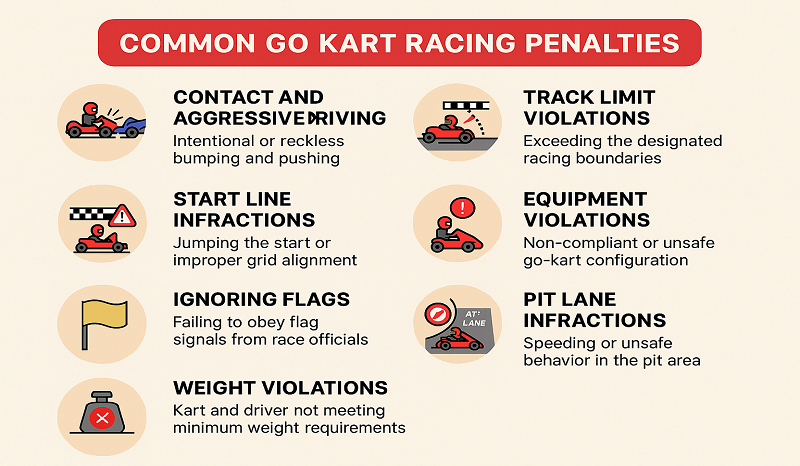So, you’re ready to hit the track and experience the thrill of go-kart racing! Awesome! But before you put the pedal to the metal, you need to understand the rules of the road (or, in this case, the track). Nobody wants to get penalized, right? Penalties can cost you valuable time, positions, and even the race itself. Think of them as unwanted speed bumps on your road to victory.
In this guide, I’ll break down the most common go kart racing penalties, explain why they happen, and give you actionable tips to avoid them. Let’s keep those black flags furled!
Key Takeaways:
- Understanding common go kart racing penalties can significantly improve your race performance and prevent costly mistakes.
- Aggressive driving, track limit violations, and equipment infractions are frequent causes of penalties.
- Maintaining a clean racing line, being aware of your surroundings, and ensuring your kart meets technical regulations are key to avoiding penalties.
- Communication with race officials and a respectful attitude towards other drivers contribute to a positive racing experience and fewer penalties.
- Knowing the specific rules of the track or racing series you are participating in is crucial.
Common Go Kart Racing Penalties

Penalties in go kart racing can range from a simple warning to disqualification, depending on the severity of the infraction. Let’s dive into some of the most common ones I’ve seen (and, admittedly, sometimes committed!):
- Contact and Aggressive Driving: This is a big one. Karting is a contact sport to a degree, but intentional bumping, blocking, or forcing another driver off the track is a no-no.
- Track Limit Violations: Most tracks have clearly defined boundaries. Going outside these boundaries, especially gaining an advantage, can result in a penalty.
- Start Line Infractions: Jumping the start, not maintaining your position, or other violations at the start of the race can lead to penalties.
- Equipment Violations: This covers a wide range of issues, from having illegal parts on your kart to failing the pre-race tech inspection.
- Ignoring Flags: Ignoring marshal flags (yellow, red, black, etc.) is a serious offense and can result in immediate disqualification.
- Pit Lane Infractions: Speeding in the pit lane, unsafe pit stops, or violating pit lane procedures can all lead to penalties.
- Weight Violations: Karts have minimum weight requirements. If your kart is underweight after the race, you’ll be penalized.
Understanding the Penalties
Let’s take a closer look at each of these penalty categories:
Contact and Aggressive Driving
This is where things can get tricky. What’s considered “aggressive” versus “fair” can be subjective. Here’s the breakdown:
- Bumping: A little bump is often unavoidable, especially in close racing. However, intentional ramming or using another kart as a brake is unacceptable.
- Blocking: Defending your position is part of racing, but blocking involves repeatedly changing your line to prevent another driver from passing. This is dangerous and generally penalized.
- Forcing Off Track: Deliberately pushing another driver off the track is a major offense. Leave enough space for other drivers to race safely.
- Dangerous Re-entry: If you spin out or go off track, re-entering the racing surface safely is crucial. Don’t rejoin the race without looking, and don’t cut across the track.
How to Avoid It:
- Be patient: Don’t force moves that aren’t there. Wait for a clear opportunity to pass.
- Leave space: Give other drivers enough room to race safely.
- Race clean: Avoid unnecessary contact.
- Be aware of your surroundings: Use your mirrors and be mindful of other drivers.
- Control your temper: Karting can be frustrating, but stay calm and race with respect.
Track Limit Violations
Track limits are usually defined by painted lines, kerbs, or the edge of the asphalt. Crossing these limits with all four wheels can result in a penalty, especially if it gives you an advantage.
How to Avoid It:
- Know the track limits: Before the race, walk the track and identify the boundaries.
- Stay within the lines: Focus on maintaining a clean racing line that stays within the track limits.
- Adjust your line: If you’re consistently running wide, adjust your line to stay within the boundaries.
- Be mindful in corners: Pay extra attention to track limits in corners, where it’s easy to drift wide.
Start Line Infractions
The start of a race is critical. Common start line infractions include:
- Jumping the start: Accelerating before the green flag.
- Not maintaining position: Moving out of your designated starting position before the green flag.
- Pushing or bumping: Contact during the start can be penalized.
How to Avoid It:
- Pay attention to the starter: Watch the starter closely and wait for the green flag.
- Maintain your position: Stay in your designated starting position until the green flag.
- Smooth acceleration: Avoid jerky movements that could cause you to jump the start.
- Practice starts: Practice your starts to get a feel for the timing and acceleration.
Equipment Violations
Before each race, your kart will undergo a technical inspection (tech). Common equipment violations include:
- Illegal parts: Using parts that are not approved for the class.
- Weight violations: Your kart being underweight after the race.
- Engine violations: Modifications to the engine that are not allowed.
- Safety equipment violations: Not having the required safety equipment (helmet, suit, gloves, etc.).
How to Avoid It:
- Know the rules: Familiarize yourself with the technical regulations for your class.
- Use legal parts: Only use parts that are approved for your class.
- Weigh your kart: Check your kart’s weight before and after each race.
- Maintain your equipment: Keep your kart in good working order.
- Pass tech inspection: Ensure your kart passes the pre-race tech inspection.
- Consider buying a used go kart that already complies with regulations.
Ignoring Flags
Marshal flags are used to communicate important information to drivers. Ignoring these flags can be dangerous and result in immediate disqualification.
- Yellow flag: Indicates a hazard on the track. Slow down and be prepared to stop. No overtaking is allowed under a yellow flag.
- Red flag: Indicates a race stoppage. Slow down and proceed to the designated area.
- Black flag: Indicates that you have been penalized and must report to the pit lane.
- Blue flag: Indicates that a faster kart is approaching to overtake you. Hold your line and allow the faster kart to pass safely.
How to Avoid It:
- Pay attention to the marshals: Watch the marshal posts for flags.
- Know what the flags mean: Familiarize yourself with the meaning of each flag.
- React appropriately: Respond to the flags as required.
Pit Lane Infractions
The pit lane can be a dangerous place. Common pit lane infractions include:
- Speeding: Exceeding the speed limit in the pit lane.
- Unsafe pit stops: Not following pit stop procedures.
- Violating pit lane procedures: Not following the designated pit lane route.
How to Avoid It:
- Know the pit lane speed limit: Pay attention to the speed limit signs.
- Follow pit stop procedures: Follow the designated pit stop procedures.
- Be aware of your surroundings: Watch out for other karts and people in the pit lane.
Weight Violations
Most karting classes have a minimum weight requirement for the kart and driver combined. This is to ensure a level playing field. Being underweight after a race results in a penalty.
How to Avoid It:
- Weigh yourself and your kart: Before each race, weigh yourself and your kart to ensure you meet the minimum weight requirement.
- Add weight if necessary: If you’re underweight, add weight to your kart.
- Secure the weight properly: Make sure the weight is securely attached to your kart.
Penalties and Race Officials
Understanding how race officials work is crucial. They’re not out to get you! They’re there to ensure fair and safe racing.
- Communication is key: If you’re unsure about a rule or penalty, ask a race official for clarification.
- Respect their decisions: Even if you disagree with a penalty, respect the official’s decision. Arguing will likely make things worse.
- Learn from your mistakes: If you’re penalized, learn from the experience and try to avoid making the same mistake again.
Tips for Avoiding Penalties
Avoiding penalties isn’t just about knowing the rules; it’s about racing smart. Here are some additional tips:
- Practice, practice, practice: The more time you spend on the track, the better you’ll become at avoiding mistakes.
- Watch experienced drivers: Observe how experienced drivers race and try to emulate their techniques.
- Get feedback: Ask experienced drivers or instructors for feedback on your driving.
- Be patient: Don’t try to force moves that aren’t there.
- Stay calm: Karting can be stressful, but stay calm and focused.
- Have fun! Remember, karting is supposed to be enjoyable. Don’t let the pressure of competition ruin the experience.
Conclusion
Understanding and avoiding go kart racing penalties is essential for success on the track. By knowing the rules, racing clean, and respecting other drivers, you can minimize your chances of getting penalized and maximize your enjoyment of the sport. Remember, racing is about more than just speed; it’s about skill, strategy, and sportsmanship.

Goran, an experienced go-kart racer, fuels GoKartLife.com with his passion and expertise. He offers valuable insights and tips for fellow enthusiasts, fostering the growth of the go-kart community. Join Goran at GoKartLife.com and immerse yourself in this exhilarating sport.
Last modified: May 8, 2025



